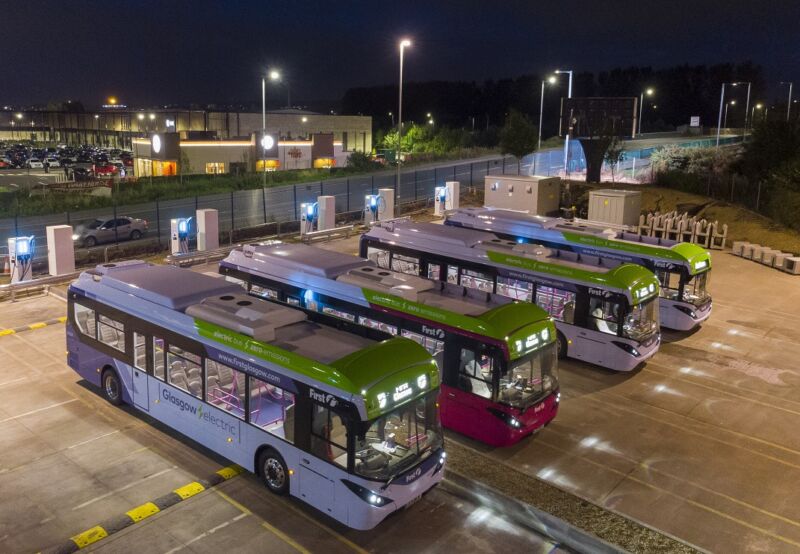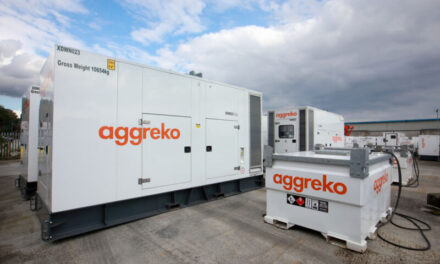First Bus, Scotland’s largest bus operator, is now able to fully charge buses in its growing electric fleet in just four hours as Phase One of a major works programme completes at what is set to be the UK’s largest Electric Vehicle (EV) charging hub.
Glasgow’s Caledonia bus depot has reached a key milestone in its green transformation plans with the installation of 11 advanced rapid 150kW dual cable charging units. This first phase of work has been completed ahead of a new batch of 22 electric buses arriving at the depot ahead of COP26, and marks a significant step forward in First Bus’ plans to have a zero-emission fleet by 2035.
With phased completion for the remainder of the work scheduled to take place across the next 12 months, the depot has been designed to accommodate and charge up to 300 EV buses on site – and will see the introduction of 150 electric buses over the next 18 months.
The state-of-the-art dual cable direct current rapid charging units have been supplied, installed and commissioned by Dutch rapid charging business Heliox, and have the power to charge a standard family car in less than 10 minutes*.
Each rapid charging station will be controlled via smart charging software to ensure that power is used in the most efficient way. This approach will help minimise the draw down from the national grid at peak times. The digital programming will also mean that each vehicle is fully charged, and the bus interiors are preheated, ready for drivers and customers from the moment the vehicles leave the depot.
With an additional 69 rapid chargers to be installed in Phase Two, Caledonia depot will soon be able to charge 162 vehicles at one time.
Janette Bell, Managing Director for First Bus UK said: “Innovative technology and electric infrastructure are key to minimising the UK’s carbon emissions, and so it’s fantastic to see this first step of our vision for the UK’s largest EV bus depot come to fruition. Our transition to a zero-emission fleet is a bold ambition, and at every stage First Bus is committed to transforming our business for the good of the environment.
“We’re proud to be putting our weight behind Scotland’s green ambitions and the completion of this first phase of works at Caledonia depot give us an exciting glimpse into the future of bus. To see this first EV charging station site completed and ready to go in Glasgow, just as the city prepares to host COP26 later this year, is a brilliant achievement.”
Following completion, the adapted depot will have the capability to charge 89% of the depot’s electric bus fleet at the same time using smart charging software. First Bus’ long-term objective is to ensure that the site is fully prepared for the transition to a 100% zero-emission fleet. This will include opportunities for further on-site renewable energy generation and storage.
First Glasgow’s fleet of 150 fully EV buses are being built by Falkirk-based manufacturer Alexander Dennis, and will arrive at the newly transformed depot in batches over the next 18 months with the final buses entering service early in 2023.
The depot transformation is being delivered thanks to over £63m of funding: First Bus is investing £35.6m into the project, while the Scottish Government’s Scottish Ultra Low Bus Scheme (SULEB) is funding a further £28.2m.
First Bus’s power solutions partner for this project, Dutch company Heliox, is a global leader in high power charging systems for public transport, trucks and heavy-duty vehicles and equipment.
Michael Colijn, Chief Executive Officer at Heliox Group said: “As we have seen, the future of e-mobility is built on rapid charging, and ensuring the charging infrastructure is in place to make this a possibility must be a priority. Our partnership with First Bus to bring versatile, convenient charging to the city of Glasgow puts us in a unique position ahead of COP26 later this year, to make a significant contribution to the discussions at the event, as well as positively impacting fleet owners across the UK. Our unique charging offering ensures fleet owners are able to effectively deploy and manage their e-fleets while serving cities of the future.”





